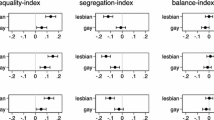Abstract
In this study we examined the division of finances, the division of household tasks, relationship maintenance behaviors, sexual activity, monogamy, and conflict among same-sex couples who had had civil unions in Vermont, same-sex couples who had not had civil unions recruited from their friendship circles, and married heterosexual couples recruited from among their siblings. Married heterosexuals had a more traditional, gendered division of finances, household tasks, and relationship maintenance behaviors, even though the heterosexuals were all siblings or in-laws of lesbians or gay men. Sexual orientation was a stronger predictor of the division of household tasks than was income difference within couples. Lesbians reported less frequent sexual activity than married heterosexual women, and gay men were less monogamous than married heterosexual men. Gay men in civil unions differed on a few variables from gay men not in civil unions, but there were no differences among lesbians.
Similar content being viewed by others
References
Blumstein, P., & Schwartz, P. (1983). American couples: Money, work, sex. New York: William Morrow.
Bussell, D. A., & Reiss, D. (1993). Genetic influences on family process: The emergence of a new framework for family research. In F. Walsh (Ed.), Normal family processes (2nd ed., pp. 1611–181). New York: Guilford Press.
Dibble, S., Roberts, S. A., & Nussey, B. (2004). Breast Cancer Risk Profiles between Lesbians and their Heterosexual Sisters. Women’s Health Issues, 14, 60–68.
Dunne, G. A. (1997). Lesbian lifestyles: Women’s work and the politics of sexuality. Toronto: University of Toronto Press.
Dunne, G. A. (1998). Living “difference”: Lesbian perspectives on work and family life. New York: Harrington Park Press.
Eskridge, W. N. (2001). Equality practices: Civil unions and the future of gay rights. New York: Routledge.
Feinberg, M., & Hetherington, E. M. (2001). Differential parenting as a within-family variable. Journal of Family Psychology, 15, 22–37.
Hickson, F. C. I., Davies, P. M., Hunt, A. J., Weatherburn, P., McManus, T. J., & Coxon, A. P. M. (1992). Maintenance of open gay relationships: Some strategies for protection against HIV. AIDS Care, 4, 409–419.
Kurdek, L. A. (1989). Relationship quality in gay and lesbian cohabiting couples: A 1-year follow-up study. Journal of Social and Personal Relationships, 6, 39–59.
Loulan, J. (1988). Research on the sex practices of 1566 lesbians and the clinical implications. Women and Therapy, 7, 221–234.
McCormick, N. B. (1994). Sexual salvation: Affirming women’s sexual rights and pleasures. Westport, CT: Praeger.
Peplau, L. A., Fingerhut, A., & Beals, K. P. (2004). Sexuality in the relationships of lesbians and gay men. In J. Harvey, A. Wenzel, & S. Sprecher (Eds.). Handbook of sexuality in close relationships (pp. 349–369). Mahwah, NJ: Erlbaum.
Peplau, L. A., & Spalding, L. R. (2000). The close relationships of lesbians, gay men, and bisexuals. In C. Hendrick & S. S. Hendrick (Eds.), Close relationships: A sourcebook (pp. 111–124). Thousand Oaks, CA: Sage.
Rothblum, E. D., Balsam, K. F., & Mickey, R. M. (2004). Brothers and sisters of lesbians, gay men, and bisexuals as a demographic comparison group: An innovative research methodology to examine social change. Journal of Applied Behavioral Science, 40, 283–301.
Rothblum, E. D., Balsam, K. F., Solomon, S. E., & Factor, R. J. (in press). Siblings and sexual orientation: Products of alternative families or the ones who got away? Journal of GLBT Family Studies.
Rothblum, E. D., & Brehony, K. A. (1993). Boston marriages: Romantic but asexual relationships among contemporary lesbians. Amherst, MA: University of Massachusetts Press.
Rothblum, E. D., & Factor, R. J. (2001). Lesbians and their sisters as a control group: Demographic and mental health factors. Psychological Science, 12, 63–69.
Schachter, F. F. (1985). Sibling deidentification in the clinic: Devil versus angel. Family Process, 24, 415–427.
Solomon, S. E., Rothblum, E. D., & Balsam, K. F. (2004). Pioneers in partnership: Lesbian and gay male couples compared with those not in civil unions, and married heterosexual siblings. Journal of Family Psychology, 18, 275–286.
Strasser, M. (2002). On same-sex marriage, civil unions, and the rule of law: Constitutional interpretation at the crossroads. Westport, CT: Praeger.
Author information
Authors and Affiliations
Corresponding author
Rights and permissions
About this article
Cite this article
Solomon, S.E., Rothblum, E.D. & Balsam, K.F. Money, Housework, Sex, and Conflict: Same-Sex Couples in Civil Unions, Those Not in Civil Unions, and Heterosexual Married Siblings. Sex Roles 52, 561–575 (2005). https://doi.org/10.1007/s11199-005-3725-7
Issue Date:
DOI: https://doi.org/10.1007/s11199-005-3725-7




